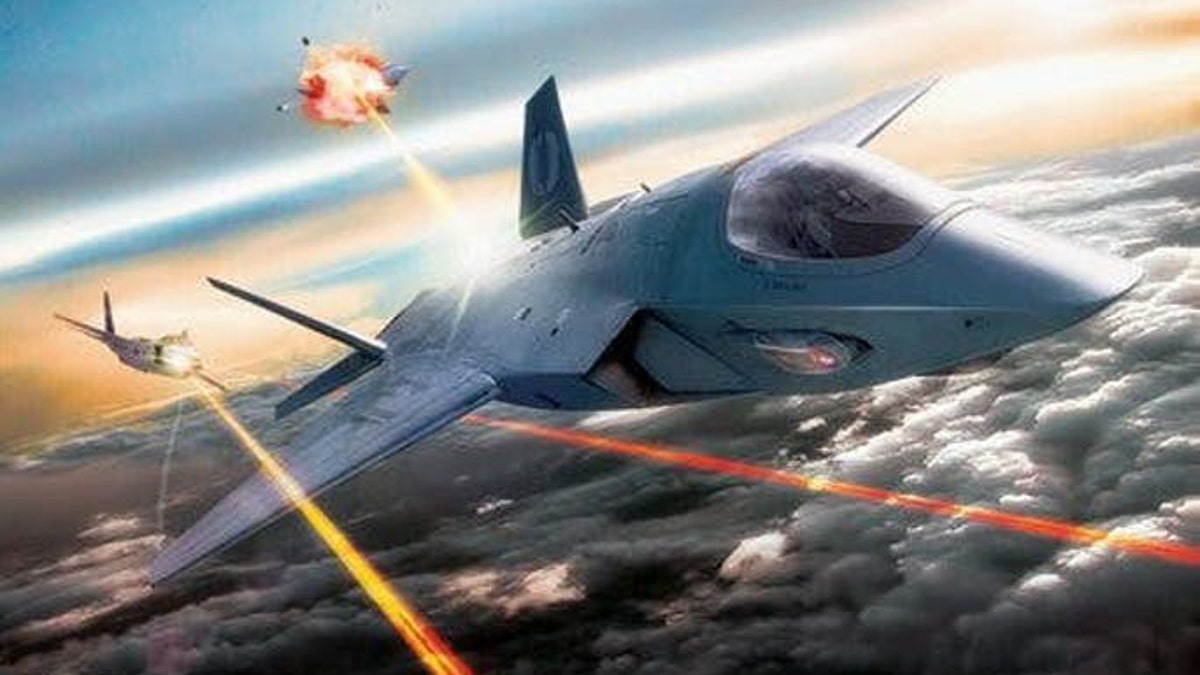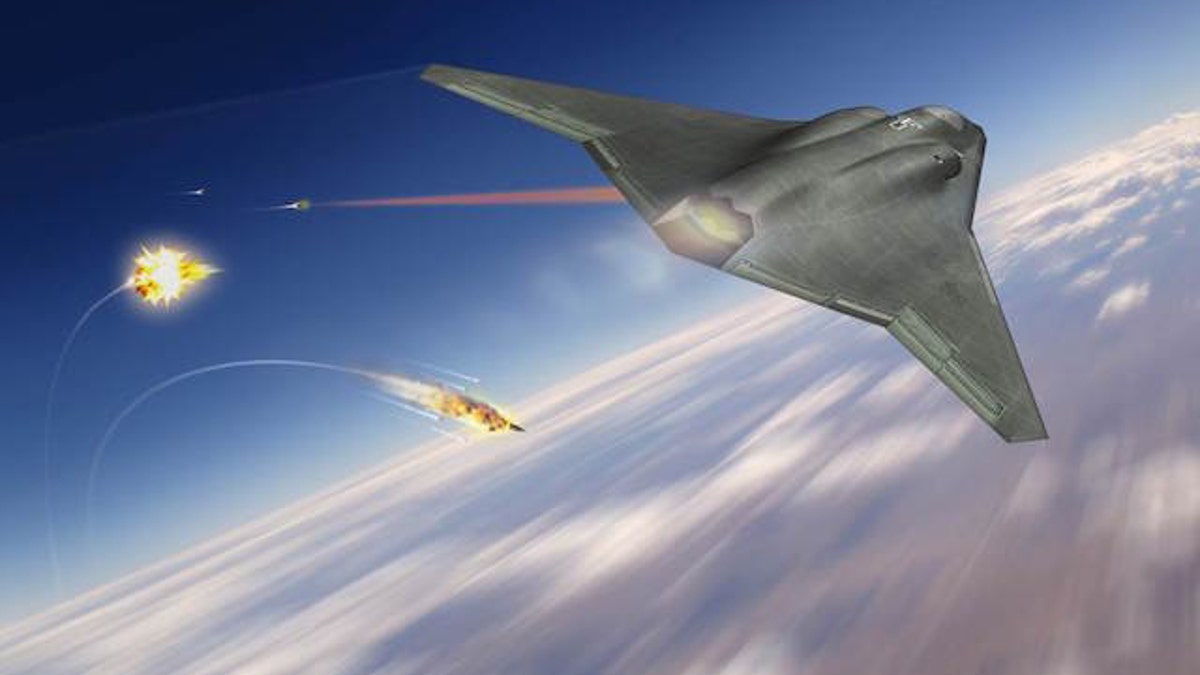
Courtesy U.S. Air Force
The U.S. Air Force is preparing to fire a fighter-jet configured laser pod from the ground as a key step toward achieving its goal of firing lasers from jets on combat missions in the air.
As a part of its preparation, the service is refining its combat strategy, tactics and concepts of operation to accommodate the rapid emergence of laser weapons, technologies which promise to alter the landscape of modern warfare and substantially expand the envelope of attack possibilities for fighter jets.
The service anticipates having aircraft and fighter jet-fired lasers in operation as soon as the early 2020s, as mobile power systems and other integral technologies continue to evolve rapidly.
Not only do laser weapons bring increased precision attacks at the speed of light to incinerate targets, but they can be scaled or adjusted to achieve the desired effect -- such as total destruction, partial damage or an even smaller, more measured impact, depending upon the threat.
WHAT HAPPENED WHEN I FIRED MY FIRST SNIPER SHOT
“Laser weapons offer warfighters opportunities for quick and precise target engagement, flexibility and lighter and more responsive support logistics,” Eva Blaylock, spokeswoman for the Air Force Research Laboratory, told Warrior Maven in a written statement.
The Air Force Research Lab, which has been leading the effort from Kirtland Air Force Base, has been working on laser weapons development for many years now. They have already conducted several ground-fire tests and are now preparing for initial air-launched demonstrations. This next test, according to AFRL information, will assess the ability of a fighter-jet configured weapons pod to successfully target and fire lasers, in anticipation of airborne integration.
The first airborne tests are expected to take place by 2021, Air Force officials have said. The developmental efforts are focused on increasing the power, precision and guidance of existing laser weapon applications with the hope of moving from 10-kilowatts up to 100 kilowatts. Air Force weapons developers are also working on the guidance mechanisms to enable laser weapons to stay on-track on a particular target.
Air Force leaders have said that the service plans to begin firing laser weapons from larger platforms such as C-17s and C-130s until technological miniaturization efforts can configure the weapon to fire from fighter jets such as an F-15, F-16 or F-35. Given the state of current technology, cargo planes are better equipped in the short term to transport the requisite amount of mobile on-board power needed for airborne lasers.
The two major ARFL programs include an air-to-air weapons program called the Self-Protect High Energy Laser Demonstrator (SHIELD) and a ground-fired Demonstrator Laser Weapon System. AFRL is working with Lockheed Martin on SHIELD in anticipation of having operational lasers within the next few years.
Solid-state laser weapons rely purely upon electricity and do not need to draw upon certain specific chemicals as other lasers do. Essentially, they can disable or, if needed, incinerate a target with tremendous heat.
PENTAGON SEEKS DRONE-FIRED LASERS TO DESTROY NUCLEAR-ARMED MISSILES
Given the advent of laser weapons, fighter pilots are preparing for new tactical possibilities, such as an ability to attack multiple targets at once and rapidly retarget, Air Force Research Laboratory papers explain. While current fighters, such as the F-35, are able to launch simultaneous air-to-air attacks on enemy targets such as planes and drones, pilots preparing to fire lasers will have an even greater ability to engage multiple targets concurrently. This, among other things, will enable fighter jets to engage in close-combat in higher risk scenarios where they might encounter multiple enemy aircraft.
Perhaps of greatest significance, laser weapons are entirely scalable, Blaylock added. Scalability is achieved in many instances by combining or merging several beams into one, AFRL states.
“The type of gradual effects a 30kW laser can deliver includes the denial, degradation, disruption, and destruction of a range of targets from UAS to small boats at a range of several kilometers. More powerful lasers have counter-air, counter-ground, and counter-sea applications against a host of hardened military equipment and vehicles at significant range,” Blaylock added.
An attack option such as this might give pilots an ability to degrade rather than destroy targets, a possibility potentially not afforded by conventional weapons such as air-to-air or air-to-ground missiles and bombs. Perhaps, for instance, an aircraft might wish to disable an enemy asset such as a plane, vehicle or enemy fixture of some kind without killing people, should civilians be in close proximity.

Courtesy of U.S. Air Force
A Congressional Research Service report from earlier this year on Directed Energy Programs, also details some of the key advantages and limitations of fast-evolving laser weapons.
“DE (directed energy) could be used as both a sensor and a weapon, thereby shortening the sensor-to-shooter timeline to seconds. This means that U.S. weapon systems could conduct multiple engagements against a target before an adversary could respond,” the Congressional report states.
As developers advance miniaturization of mobile, onboard power system, fighters and cargo aircraft will increasingly operate with an ability to carry a “deep magazine” without adding large amounts of weight to a plane. This brings a number of distinct advantages, such as greater fuel efficiency, speed and maneuverability. A transportable arsenal of laser weapons might remove the need for a fighter jet to travel with large amounts of heavy bombs and missiles, allowing the aircraft to operate with increased air-to-air maneuverability and extended mission time.
MEET THE 29-YEAR-OLD SCIENTIST BEHIND THE FIRST IMAGE OF A BLACK HOLE
A lighter-weight aircraft, naturally, will have increased “dwell” time to seek emerging targets by virtue of not having to refuel as often. As something able to operate with a decreased “logistical footprint,” a laser-armed fighter jet may also operate for longer periods of time without needing to re-arm, generating yet another avenue through which to extend missions.
“For a 30 kW laser system, the batteries could weigh on the order of 300 pounds and fit within a volume of half of a cubic meter,” the AFRL essay states.
All of this means pilots and ground-weapons operators will need to employ new tactics and concepts of operation as they prepare for longer, faster missions and prepare for the ability to launch scalable attacks. Laser power is increased, AFRL developers explain, by use of a two-color fiber amplifier.
Alongside these known advantages, laser weapons development also faces a number of substantial hurdles as it comes closer to operational status, according to AFRL information.
Not only do laser weapons need to be further ruggedized for war, but various “beam controls” need to be integrated to optimize precision and preclude the impact of “aero-mechanical jitter."
“Beam control systems must be adequately advanced so as to enable precise aiming, tracking, and pointing amidst the aero-mechanical jitter induced by vibrations during flight,” an AFRL paper states.
If system “weight and heat” are properly managed, there will be much less beam attenuation or dispersion of the laser impact.
“High-speed aerodynamic flow must be mitigated to avoid aero-optical disturbances,” AFRL data states. “Effective thermal management systems can drastically increase the rate of fire, either through traditional liquid cooling loops or through two-phase cooling, wherein heat is transferred to and melts a solid, the resulting liquid of which is then cooled.”
Defensive laser weapons are bringing great promise to the US military as well. Given that laser can also perform a sensor function, they might be able to acquire and knock out an incoming enemy missile. They could operate as "interceptors" traveling at the speed of light, offering a quick way to destroy enemy attacks, which could include anti-ship missiles, air-to-air missiles and even space-based weapons such as ICBMs. This is attractive to weapons developers for tactical and financial reasons, as lasers are extremely low cost to fire and could be equally effective against an incoming attack as compared to an expensive interceptor missile.
The Army and Navy are also moving aggressively to develop and deploy offensive and defensive laser weapons. (stay tuned for more Warrior Maven Laser reports)




















